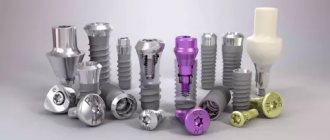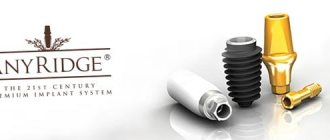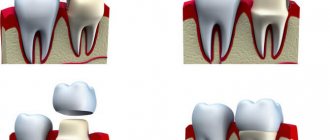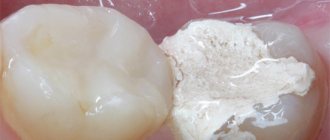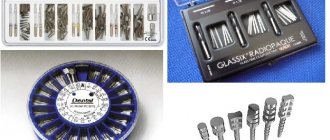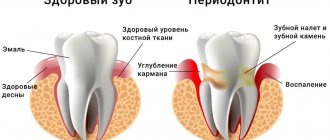Hidden caries (both under a filling and on a “healthy” tooth)
As a rule, such caries develops asymptomatically, for more than one month or even a year, it does not manifest itself in any way, but destroys the tooth tissue from the inside. And at some inopportune moment, a part of the tooth, thinned by caries, breaks off.
What to do?
Treat the tooth at the dentist: remove all tissues affected by caries and restore the tooth (with a filling, ceramic inlay or crown, depending on the degree of its destruction). And be sure to check all other teeth for hidden caries!
How to avoid?
See your dentist for preventive examinations more often in order to promptly detect hidden caries at an early stage, when treatment is easier, faster and cheaper.
Diagnostic measures
If the tooth has broken off to the gum line, the dentist will conduct an examination. He is studying:
- whether the surrounding areas are damaged;
- are there necrotic areas?
- whether blood got into the dental cavity;
- what condition are the roots in?
To clarify the situation completely, the patient is asked to undergo an x-ray. From the image you can understand whether the roots have shifted, whether the nerve fibers are damaged, and what condition the remaining solid structures are in.
Incorrectly restored tooth
- Poor performance of the filling , violation of technology and methodology during restoration (we will not dwell on this).
- The type of restoration is inadequately selected, in a word, “too big a filling” (i.e. they put a filling in cases where it can no longer be placed, but there are all the indications for “more serious” ceramic restorations (inlays, crowns).
I would like to dwell on the second reason in more detail.
Competent dentists know that there is an index of tooth surface destruction (DSI), which must be taken into account before restoring teeth in order to do it correctly. For you, dear patient, I will describe it in a simplified way. If the tooth is not severely damaged (conditionally up to 40% of the surface), a filling is an excellent way to restore it. Destruction of 40 to 70% of the surface requires the manufacture of a ceramic inlay or strengthening of the tooth with various pin structures.
If there is a significant degree of destruction of the tooth surface (more than 70%), the tooth should be correctly restored with a crown. In a word, the type of tooth restoration depends on the degree of destruction.
What's wrong with a filling?
Each recovery method has its own indications. So, a filling is necessary and can be placed in cases of small and medium degrees of tooth decay. If the decay is significant, a large filling can split the tooth in half.
Let's find out why!
Any material (even metal) expands when heated (remember the temperature of the tea you drink!). Temperature changes are a fairly common occurrence that our teeth encounter (from hot tea to ice cream). The coefficient of thermal expansion of filling materials is still higher than that of tooth tissue. That is, when hot food is consumed, the filling expands more than the tooth tissue that surrounds it. The larger the volume of the filling, the greater the expansion (this is why a large volume of the filling is so undesirable).
Of course, this expansion is minimal, not noticeable to any eye and not perceptible. However, add to it a chewing load (which far exceeds temperature deformations), a large filling, thinned tooth tissue, and the likelihood of chipping increases many times over.
Unlike filling materials, ceramics (from which crowns and inlays are made) have a closer coefficient of thermal expansion to the tooth tissues, and therefore do not contribute to its chipping. In addition, it is stronger. That is why it is correct to restore severely damaged teeth not with fillings, but with ceramic restorations. There are other physical phenomena that affect the change in the size of the filling and, as a result, the splitting of the tooth.
All of the above, of course, is true only with an adequately completed restoration (even fillings, even crowns). An inaccurate hand of a master can lead to chipping even with ceramic restorations, and on the contrary, a skillful hand can place a large filling so that it will last a long time. However, there is a limit to everything and it is better not to go beyond the indications for restorations if you want to get guaranteed and reliable work.
Conclusion : you should not expand the indications for conventional fillings too much; they are not capable of qualitatively restoring a badly damaged tooth. But in case of minor tooth decay, fillings have proven themselves to be excellent!
Let me give you a photographic example.
The patient complained that it was painful for her to bite on one of her teeth, that something “crunched” in it.
Upon examination, we determined: tooth 4 on the upper jaw: it has a medium-sized filling (at first glance). And a movable, broken tooth wall, which is held together only by the gums. This wall is no longer attached to the tooth.
The broken fragment of the tooth is mobile, easily moved to the side, but has not yet been removed.
View of the tooth after removing the broken wall: the cheek wall was chipped under the gum. A large filling and a thin remaining tooth wall on the palatal side are visible. Some doctors may try to restore such a tooth using a crown (with preliminary extension); some doctors will offer a perhaps more predictable option: removal and subsequent implantation.
Why are teeth restored incorrectly?
It’s absurd, but often the dentist follows the patient’s lead. The patient, not fully understanding all the subtleties and features of the distribution of the load when chewing, refuses the inlay or crown and asks the doctor to “put a filling”, they say, I’ll work with it a little more, and only then the crown! As a result, at the most inopportune moment, a “piece” of the tooth breaks off. As a result, such “pity” of the doctor for the patient turns out to be a bigger problem for the patient than timely adequate tooth restoration.
By clicking on the “Make an appointment” button, I consent to the processing of my personal data.
I have read and agree with the conditions for processing personal data set out on the website ds-chocolate.ru.
Consent to the processing of personal data
How to properly restore teeth?
When treating a tooth, the doctor must remove all carious tissues, old fillings, movable walls, if any, completely clean the tooth and only then assess the degree of destruction (which walls and cusps have survived, whether they are able to bear the load, how the load on this tooth will be distributed during different methods of restoration, whether chips of any wall are possible, whether its restoration will lead to a split of the root, etc.). After such an assessment, it is determined how to properly restore the tooth: is it possible to put a filling, or does it need to be “strengthened with a pin,” or would it be more correct to use a ceramic inlay or a crown.
Conclusion: a properly selected restoration will preserve the tooth for many years, protect it from further destruction, and the patient from having to redo the work in a few years.
Causes
The root of a tooth or its crown can break for various reasons. The most common:
- genetically determined anomalies in the structure of hard dental tissues;
- metabolic disorders caused by problems with the absorption of calcium, phosphorus, fluorine;
- rickets;
- unbalanced diet;
- diseases of the gastrointestinal tract, due to which the level of acidity of saliva changes sharply.
Among the external factors leading to dental fractures, the following should be mentioned:
- blows to the head during a fight, sports, or traffic accidents;
- damage to the unit due to careless dental procedures;
- habit of gnawing hard foreign objects, crackers, candies;
- simultaneous consumption of very hot and cold foods or drinks;
- malocclusions, due to which increased pressure is placed on individual units;
- advanced caries, reducing the volume of healthy hard tissues.
Injury
Single or chronic - the third reason for possible tooth chips
A single injury occurs when there is a blow, an accident, or accidentally biting on a hard object while chewing.
There are three types of chronic injury
- Due to malocclusion (when the teeth do not close correctly, some teeth may receive excessive load, close in the wrong areas, at the wrong angle, or with an opponent that is not their power). For example, a powerful fang of the lower jaw can be positioned in such a way that when closed, it will severely injure the incisor on the upper jaw, which is much inferior to it in size and power. As a result of such long-term closure, the incisor can get into big problems, and the patient will face the need for treatment or removal.
- Due to the absence of other teeth (when a number of teeth are missing, their work is performed by the remaining ones; excessive load may one day result in a fracture of the tooth, a break in its wall, or a split in the root).
- Due to bruxism (“idle” teeth grinding) or other parafunctional manifestations.
How to avoid?
- Be sure to restore missing teeth (there are a lot of ways today, there are even temporary prosthetics if for some reason you need to postpone dental treatment).
- Consult an orthodontist, orthopedist or periodontist about bite problems and undergo orthodontic treatment if indicated.
- Get advice from an orthopedist/gnathologist and psychotherapist about the possible causes of bruxism and take possible measures that the doctor recommends.
Content:
- Causes
- Signs of a fracture
- What to do
- Diagnostic measures
- What to do if the root is preserved
- When you have to remove a broken tooth along with the root
- How to avoid a fracture
A tooth fracture is a serious dental injury.
It manifests itself as sharp pain and a change in the appearance of the crown. It requires urgent reconstructive measures, since exposed tissues are unprotected and are easily destroyed under the influence of various external factors. It is important to understand that if a tooth is broken at the root, the situation can definitely be corrected. In some cases, doctors are able to “grow” the fragment back. But most often the issue is resolved with the help of prosthetics.
What to do if your tooth chipped?
See a dentist.
The doctor will remove the broken wall, take x-rays of the tooth, and evaluate its safety. If the tooth is not broken much, the root is not damaged or almost not damaged, then it can be restored. Then the tooth is prepared (if necessary, dental canals are treated, caries and old filling materials are cleaned), how badly it is damaged is assessed and the best way to restore it is selected (filling, inlay or crown). If the tooth cannot be saved, it is removed and replaced with an implant or other available method.
What to do
It is important to get an appointment with a dentist as soon as possible. But it is clear that it is not always possible to do this within the next few hours. During the waiting period you should:
- Take painkillers. It will help “dull” the unpleasant sensations.
- Rinse your mouth with clean warm water or a decoction of anti-inflammatory herbs. This simple manipulation will help get rid of sharp fragments, if any have formed.
- Apply a bandage soaked in antiseptic to the damaged area. Due to this, the wound will be reliably protected from the penetration of pathogenic microorganisms and food debris. Bleeding will also stop faster thanks to the application.
- Apply a cold compress to the cheek on the side of the injury.
- Immobilize the jaw by applying a tight bandage.
Under no circumstances should you wait longer than a few hours for a fractured dental crown. You can always go to the dentist without an appointment - no responsible doctor would dare refuse to see you in such a critical situation.
Tooth restoration with preserved root
The possibility of restoring a tooth without radical measures appears in the following cases:
- in the absence of an inflammatory process and preservation of root canal tissues;
- with a stump size of at least 3 mm and a thickness of the remaining tooth walls of at least 1 mm.
If the tooth fragment is almost invisible from under the gum, restoration cannot be performed.
Restored a missing tooth with an implant
Restoration technologies with preserved root:
- formation of an anatomical structure based on the stump using composite filling materials coated with a crown;
- restoration by implantation of a fiberglass pin. The pin is used as a rod to more firmly attach a new tooth formed from filling material and a crown. The technology is widely used in cases where the amount of preserved external tissue is minimal;
How to install fiberglass pins
- a stump inlay coated with a crown is an innovative method of microprosthetics. In the dental office, an inlay is made from high-quality non-toxic materials with biological inertness (gold, platinum, cobalt, nickel, zirconium) and embedded deep into the root canal. Teeth restored using this technology are in no way inferior to natural ones in strength and retain their functions for 10 years or more.
Stump inlays
Preventive crown care
In order not to provoke the accumulation of masses under the crown and cause tooth decay, it is necessary to maintain oral hygiene. A crown is an artificial structure and will require more care.
- Brush your teeth twice a day, including using special brushes for caring for dentures.
- Rinse your mouth after every meal.
- Floss regularly.
- Use toothpicks only when necessary. This is not at all a means of maintaining dental hygiene! Picking with a wooden stick, expanding cavities in teeth and crowns, is contraindicated.
If you have already had the sad experience of tooth decay under a denture, pay more attention to the alarm bells: pain under the crown, bad smell, taste of blood in your mouth. Make an appointment with a dentist; timely treatment will be shorter and cheaper than treatment for a neglected tooth.
If you realize that the tooth has begun to rot, remember that the process is irreversible. It will not be possible to cure inflammation with home methods. You should not wait until there is severe pain or the crown falls out in your sleep, with the risk of suffocation. A diagnosis from a doctor will help you cope with the problem.
Make an appointment at Dr. Lopaeva's clinic
Make an appointment
Or call +7(985)532-21-01
